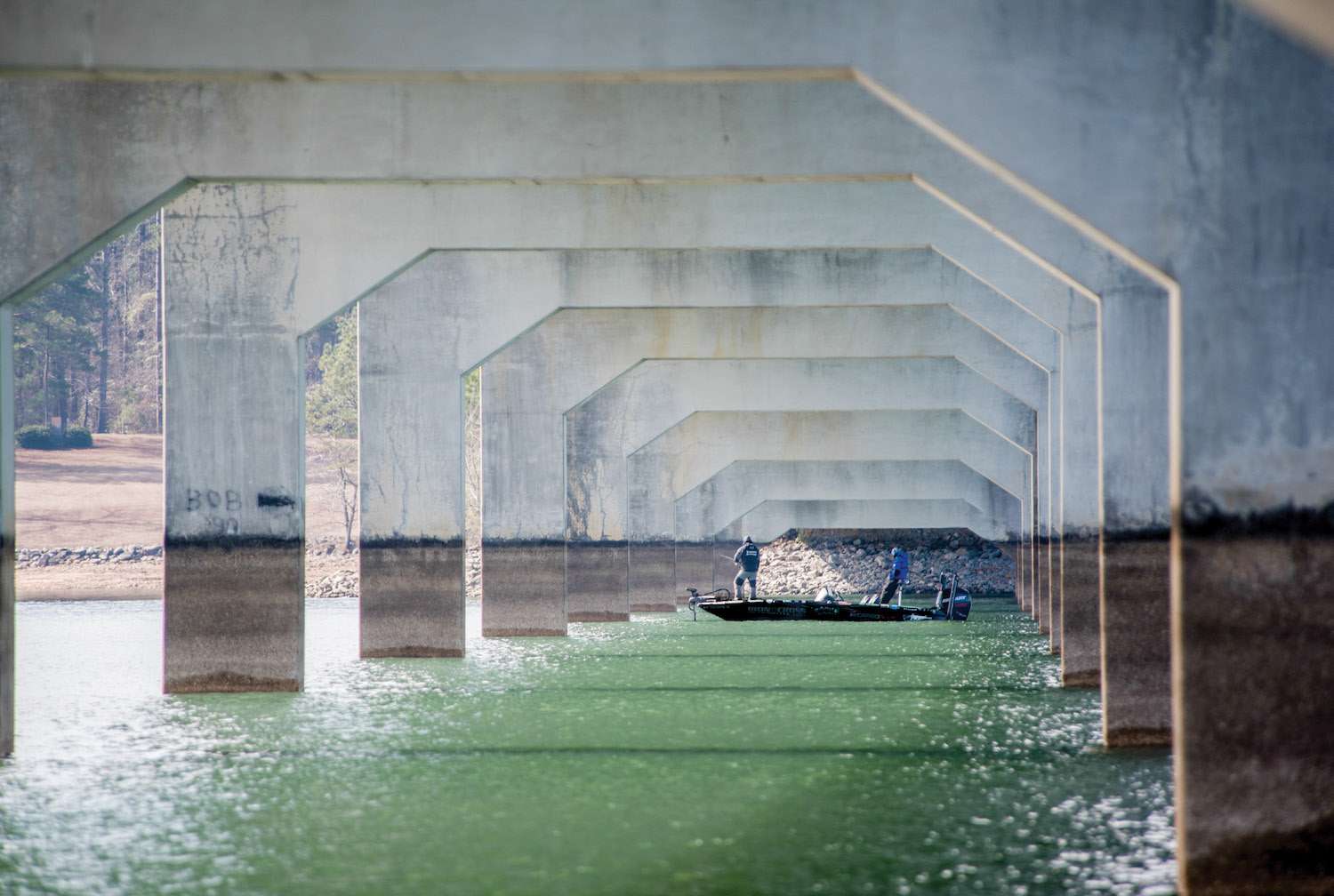
Shade, shelter, pinch points, bait aggregators — yeah, we know why bridges rank as top-shelf fish magnets, but what if the fish didn’t get the memo? Or, maybe they just blew off the meeting? Well, you can keep on keepin’ on, or you can dig into the bag of tricks to tease, tempt and taunt your targets into making a mistake.
Sometimes, this requires a position change — subtle or not so subtle — while other instances find a creative bait or presentation flips the switch. We asked a few Bassmaster Elite Series pros for their insight on bridge-fishing tactics that some may be overlooking. Here’s what they shared.
Off the beaten path
David Fritts is no stranger to cranking bridges, but when the bite’s tough, he knows he has to shift gears; but that doesn’t mean decking his crankbait rod. Rather, it often means finding a different place to present that tried-and-true bait.
“When fishing is tough, the crankbait bite can be at its best because you can get a reaction strike out of it,” Fritts says. “I’m going to figure out not only what color they want, but exactly how deep I need to be fishing.
“In tough conditions, you try to fish where not every crankbait has passed by. That may be underneath a low bridge; I can get on one side and throw all the way underneath and out the other side. That kind of stuff doesn’t get fished as much.”
And what about those traditional ambush spots, like the corners of causeway riprap? Fritts often finds heavy fishing pressure pushing bass off the textbook stuff — but not entirely.
A lot of times, he said, the ambush spot is not on a corner, but around the corner. Dissatisfied with the obvious stuff, the fish might simply ease back from the heavily pressured areas, so don’t completely bail on the idea; simply adjust your positioning — and remain open-minded.
“Where you least expect to get a bite, that’s probably where you’re going to get it,” Fritts says.
“Sometimes, it’s the angle at which you’re throwing on the bridge. If I’m going down the bridge and I haven’t had a bite, I’ll turn around and come back the other direction and catch five.”
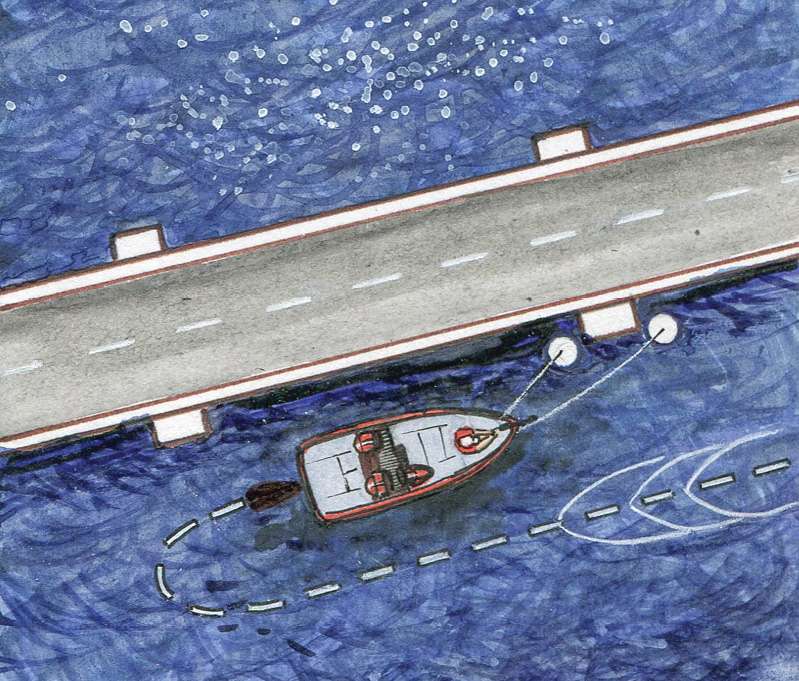
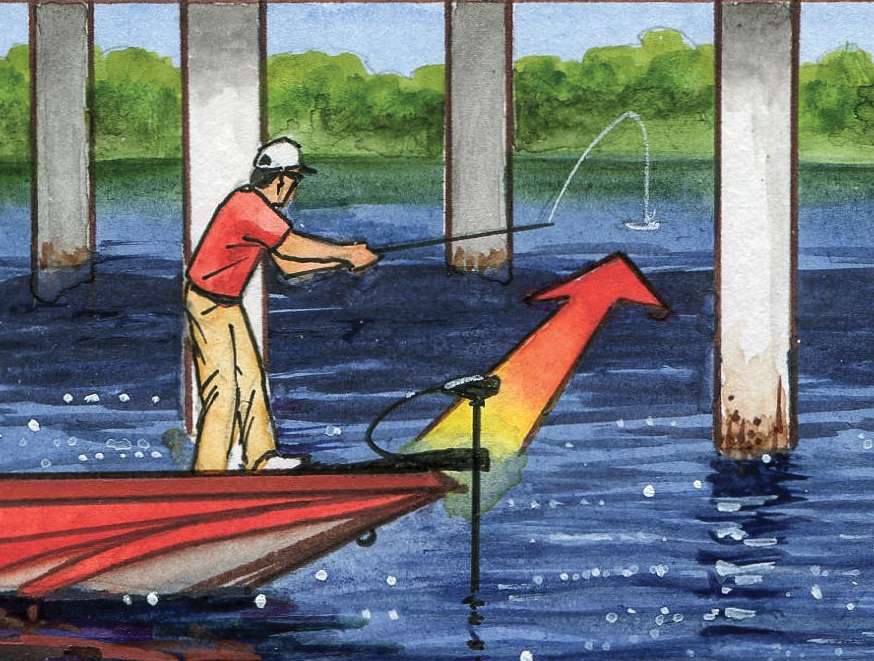
Don’t dis the trash pile
Noted bridge aficionado Keith Combs spends plenty of time between a bridge’s causeway points and the pilings, but he encourages anglers to also visit the landward ends, where wind and waves pile up wood and debris. Drawdowns and seasonal water fluctuations may vary how much structure remains fishable, but there’s almost always something sitting in cast-worthy water.
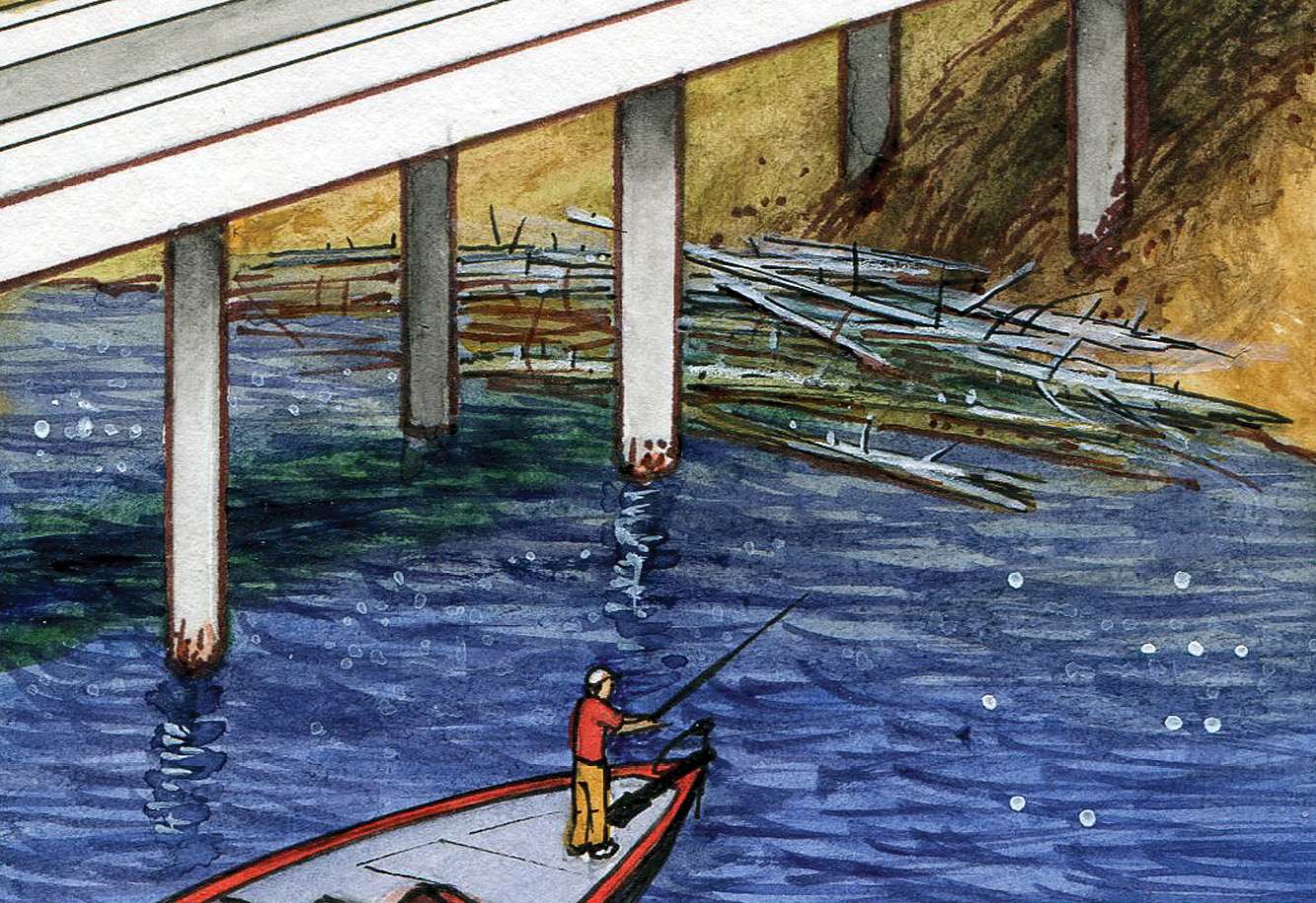
Baitfish and bream may take refuge here, so you can bet the isolated buffet will not go unnoticed by opportunistic bass. Productive tactics include flipping, pitching and maybe a squarebill or spinnerbait around the perimeter. If there are any blown-in weed mats, a frog might find a taker, as will a Texas-rigged beaver or creature bait.
This is rarely a winning pattern, but it can offer that limit-making safety valve that’s so often the difference between bombing and making the check cut.
Spin to win
Elite angler Mark Menendez of Kentucky confronts tough bridge conditions by throwing a Strike King Tour Grade Spin Head with a Strike King Caffeine Shad and slow rolling it around the pillars and riprap corners. Fishing these obvious current spots is key, but precision matters.
“Angles are very important when you’re dealing with man-made structure, as is counting it down to where the baitfish are, and the rest is pretty easy,” Menendez says. “I can control this bait well; it looks like a shad and it’s a high-percentage, high-hookup bait.
“And it appeals to all three species, so you might catch a brown one, you might catch a spotted one and you might catch a green one.”
Death circles
When Combs needs a big bridge bite, he often turns to a 7-inch Strike King Caffeine Shad — but probably not in the form or presentation most are accustomed to. Rather, the Texas pro rigs his big bait for a tantalizing downward spiral that mimics the easy pickings of a wounded gizzard shad.
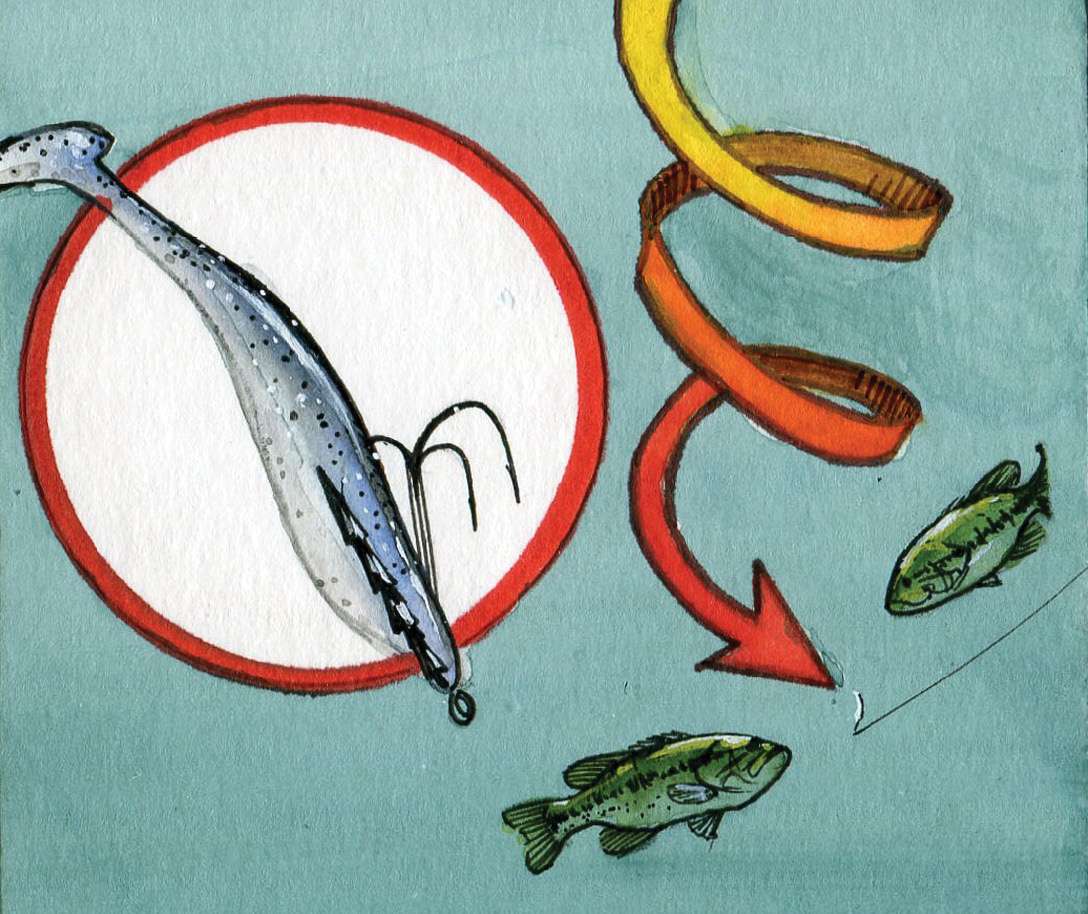
Combs inserts a 1/16- to 1/8-ounce nail weight into the bait’s nose for a downward tug that initiates the presentation. Next, he sticks one arm of a No. 2 treble hook into the shad’s back.
This arrangement makes the bait fall faster and with a circling descent. It also ensures optimal hookup success, as the treble’s two free arms firmly grab whatever bites. Maintaining contact with the bait is key, and that sizable bait helps here.
Parting shots
Low And Slow: Hank Cherry’s a big fan of spinnerbaits, but when the bridge game becomes challenging, he’ll turn to a single Colorado blade spinnerbait. The logic, he said, is forgoing the flashy profile and lift of a twin willowleaf bait for something he can keep in front of the persnickety ones.
“With that single Colorado blade, you can pull it slower, keep it closer to the bottom and attract more lethargic fish,” Cherry said. “You can do more things with it than you can a tandem spinnerbait.”
A Different Drop: Drop shots and bridge pilings get plenty of face time, but if you’re only doing the vertical deal, you’re likely missing significant opportunities. For one thing, you may have suspended fish that may not feel like chasing your bait to the bottom. Here, a long cast past the piling allows for a pendulum swing along the structure. Fiddling with the weight size and sink time will bring your bait through different zones until you figure out what makes ’em bite.
Another creative look for picky bridge bass: Wrap your drop shot around the face of a piling by casting across the upcurrent side right as you drift past. You’re essentially using the oncoming current to pin your rig against the structure, to resemble a baitfish feeding on piling algae. Definitely a timing deal, this ruse requires keen attention to keep your boat in the proper position, not only for the right amount of tension, but also to quickly react to a bite before excessive pressure against a rough surface risks a break-off.
Perimeter Plan: Sunshine plus solid object equals shade — and when we’re talking bridges, that protruding shade line sets up an ambush-feeding scenario not unlike the edge of a weed mat, a grassline or a marina pier. Though lacking physical form, the shade line allows bass to lurk in lower visibility and use that dark-to-light transition to pick off unsuspecting prey.
Take your first shot with reaction baits — something to trigger the most aggressive fish with their noses on the shadow line. After that, pick off the ones holding a little deeper with a swimming worm, a drop shot or maybe a grub on a light jighead.
Keep in mind that shadow lines change with sun angles, so adjust as needed to maximize the opportunity to target fish that are largely overlooked.
Second fiddle
One of the biggest bridge mistakes you can make is overlooking one of these fish magnets entirely. It’s hard to do with the major structures, like Toledo Bend’s Pendleton Bridge, the Natchez Trace Parkway Bridge across Pickwick or the Potomac’s Woodrow Wilson Memorial Bridge, but sometimes, the more modest crossings are irreverently ignored en route to sexier destinations.
Maybe it’s that small, local road bridge spanning the mouth of a spawning bay/creek. You know there’ll be lots of staging spots for pre- and postspawners once you turn off the main lake, but don’t overlook those bridge pilings for this role.
And what if a river fishery is so rich, you can successfully fill a day working that offshore structure? Well, Elite angler Brandon Lester said the occasional bridge may be an afterthought for most, but that’s precisely why he saved some time for the one near Ogdensburg during his third-place finish in last year’s St. Lawrence River event.
“I spent most of my time fishing main-river shoals in 25 to 40 feet, but I caught fish on this bridge during practice, so I saved it for the last day of the tournament,” Lester says. “It was an obvious spot, but a lot of guys pass it by when they’re running up and down the river.
“Those bridge pilings are a lot like those big boulders in the river because they break the current. That’s how I caught a few fish — in the current eddies.”
Drop shots with goby imitators rigged on No. 4 Mustad Titan-X Wacky/Neko hooks produced several key fish on Day 3, including a 4 1/2-pound smallmouth that ended up being his largest. Noting the similarities to dialing in particular main-river structures, Lester said he gave each bridge piling a good look but ultimately found a quartet of productive legs.
Lesson: Keep checking until you ID the hot targets.
Bridges create more casting targets than just the pilings and rocks that create them. Combs always looks for the debris piled up near bridges. Typically, this junk ends up where the current is slack, offering a prime target for pitching plastics.
Originally published in Bassmaster Magazine 2019.





